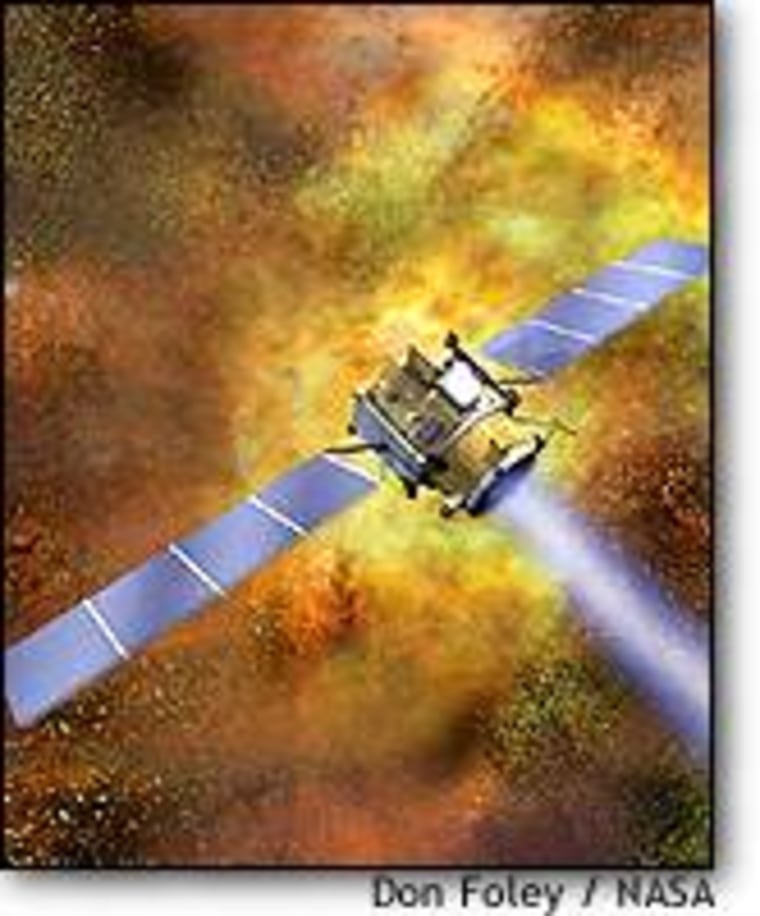Deep Space 1 is an experimental spacecraft that can think for itself and uses an ion drive that evokes “Star Trek” and “Star Wars.”
THE HALF-TON SPACECRAFT blasted off in October 1998 aboard a low-cost Delta rocket, on a trajectory allowing it to observe an asteroid and perhaps two comets. But those flybys weren’t the central point of the $152 million mission. Rather, the primary aim of Deep Space 1 was to test out a dozen new technologies that could be used on future space probes.
The first two technologies — the solar array and the radio — proved that they were working the very first time controllers heard from the spacecraft after launch, said Marc Rayman, chief mission engineer and deputy mission manager of Deep Space 1 at NASA’s Jet Propulsion Laboratory.
ACTIVATE THE ION DRIVE
But the “coolest technology,” Rayman said, is Deep Space 1’s ion propulsion system.
With Deep Space pushed beyond Earth’s orbit by a low-cost Delta rocket, the ion drive pushed slowly into deep space. Such a system has been used before for adjusting satellite orbits, but “nobody’s ever used ion propulsion to send a spacecraft someplace,” Rayman said.

Another cool feature is DS1’s remote agent software. Spacecraft engineers worked with experts in artificial intelligence to come up with a program that, in principle, could fly DS1 by itself. Given the goals of the mission, DS1’s onboard computer can draw up a mission plan, put it into effect and check to make sure it’s having the desired result.
“We’re thinking of it as an agent of the human operators on the ground to make their job easier,” said Doug Bernard, project element manager for the remote agent experiment. “If the spacecraft can take more of the burden on itself, that will allow the ground controllers to be thinking more on the big-picture level.”
Yet another cool idea relates to Deep Space 1’s Miniature Integrated Camera Spectrometer, or MICAS. This one instrument is used for three purposes: to gather science data, provide images for the spacecraft’s onboard navigation system, and provide an engineering testbed for future observing instruments.
There are two channels for black-and-white imaging, an ultraviolet imaging spectrometer and an infrared imaging spectrometer — but all those functions piggyback on one 4-inch-diameter telescope.
“Instead of having separate instruments, all of the channels are combined in one telescope,” said Pat Beauchamp, whose team developed MICAS.
Beauchamp said the $8 million MICAS instrument provides 85 percent of the capability of a similar instrument aboard the Cassini probe to Saturn, for “a tenth of the power, a tenth of the mass, a tenth of the dollars.”
BEYOND COOL
NASA isn’t trying out these technologies just because they’re cool. The whole idea is to make space exploration cheaper and more manageable.
“It’s like having your car find its way from Los Angeles to Washington, D.C., arrive in a designated parking space, and do it all while getting 300 miles per gallon,” Rayman said.
Translated into less metaphorical terms, Rayman explained that ion propulsion would be 10 times more efficient than conventional chemical propulsion systems, and more intelligent software would clear the way for a proliferation of smart probes that won’t be as taxing on space communication networks and mission control centers.
The technology tested on Deep Space 1 could come into its own in a new generation of space probes ranging from Mercury to Pluto and beyond, Rayman said.
“The reason that nobody has ever tried it is because it’s risky,” he said. That’s why DS1 was set aside to make sure the technologies actually work in deep space.
“We take the risks so future missions don’t have to,” Rayman said.
Deep Space 1 successfully tested all its technologies and flew past the Asteroid Braille in July 1999.